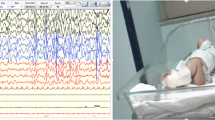Summary
Rett syndrome is a progressive encephalopathy restricted to the female sex. In the present paper a possible genetic cause for this syndrome is discussed, based on data from the literature as well as our own. Our results are in agreement with others regarding no increase in parental age, or in spontaneous abortions rate among the mothers of affected children and with a normal sex ratio among sibs. We have found no chromosome rearrangement detectable with the methods used and no correlation between fra(X)(p22) and the Rett syndrome. We have observed an alteration in the sequence of replication in one of the two types of late-replicating X-chromosome present in normal women, and suggest that this may signify that genes which are active in the late-replicating X-chromosome are inactivated (or vice-versa) in these patients. This fact could be related to the abnormal phenotype observed in Rett syndrome patients.
Similar content being viewed by others
References
Al-Matten M, Philippart M, Shields D (1986) Rett syndrome: a commonly overlooked progressive encephalopathy in girls. Am J Dis Child 140:761–765
Coleman M, Naidu S, Murphy M, Bias W (1987) A set of monozygotic twins with Rett syndrome. Brain Dev 9:475–478
Comings DE (1986) The genetics of Rett syndrome: the consequences of a disorder where every case is a new mutation. Am J Med Genet 24 [Suppl 1]:383–388
Gilberg C, Wahlstrom J, Hagberg B (1985) A new chromosome marker common to Rett syndrome and infantile autism? The frequency of fragile sites at Xp22 in 81 children with infantile autism, childhood psychosis and the Rett syndrome. Brain Dev 7:365–367
Hagberg B (1985) Rett's syndrome: prevalence and impact on progressive severe mental retardation in girls. Acta Paedatr Scand 74:405–408
Hagberg B, Witt-Engerstrom I (1986) Rett syndrome: a suggested staging system for describing impairment profile with increasing age towards adolescence. Am J Med Genet 24 [Suppl 1]:47–59
Hagberg B, Witt-Engerstrom I (1987) Rett syndrome: epidemiology and nosology —progress in knowledge 1986 —a Conference communication. Brain Dev 9:451–457
Hagberg B, Aicardi I, Dias K, Ramos O (1983) A progressive syndrome of autism, dementia, ataxia and loss of purposeful hands use in girls — Rett syndrome: report of 35 cases. Ann Neurol 14:471–479
Hagberg B, Goutieres F, Hanefeld F, Rett A, Wilson J (1985) Rett syndrome: criteria for inclusion and exclusion. Brain Dev 7:372–373
Hanefeld F (1985) The clinical pattern of Rett syndrome. Brain Dev 7:320–325
Johnson WG (1980) Metabolic interference and the ± heterozy-gote. A hypothetical form of simple inheritance which is neither dominant nor recessive. Am J Hum Genet 32:374–386
Killian W (1986) On the genetics of the Rett syndrome: analysis of the family and pedigree data. Am J Med Genet 24 [Suppl 1]:369–379
Moore JW, Tuck-Muller CM, Murphy M, Naidu S, Thomas G (1986) Chromosome studies in 10 patients with the Rett syndrome. Am J Med Genet 24 [Suppl 1]:345–354
Opitz JM (1986) Rett syndrome: some comments on terminology and diagnosis (Editorial comment). Am J Med Genet 24 [Suppl 1]:27–37
Otto PG (1978) Studies on the human X chromosomes. PhD thesis, Instituto de Biociências, Universidade de São Paulo
Partington MW (1988) Rett syndrome in monozygotic twins. Am J Med Genet 29:633–637
Riccardi UM (1986) The Rett syndrome: genetics and the future. Am J Med Genet 24 [Suppl 1]:389–402
Romeo G, Archidiacono N, Ferlini A, Rocchi M (1986) Rett syndrome — lack of association with fragile site Xp22 and strategy for genetic mapping of X-linked new mutation. Am J Med Genet 24 [Suppl 1]:355–359
Seabright M (1971) A rapid banding technique for human chromoomes. Lancet II:971
Tariverdian G, Kantner G, Vogel F (1987) A monozygotic twin pair with Rett syndrome. Hum Genet 75:88–90
Wahlstrom J, Anvret M (1986) Chromosome findings in the Rett syndrome and a test of a two-step mutation theory. Am J Med Gent 24 [Suppl 1]:361–368
Author information
Authors and Affiliations
Rights and permissions
About this article
Cite this article
Martinho, P.S., Otto, P.G., Kok, F. et al. In search of a genetic basis for the Rett syndrome. Hum Genet 86, 131–134 (1990). https://doi.org/10.1007/BF00197693
Received:
Revised:
Issue Date:
DOI: https://doi.org/10.1007/BF00197693




